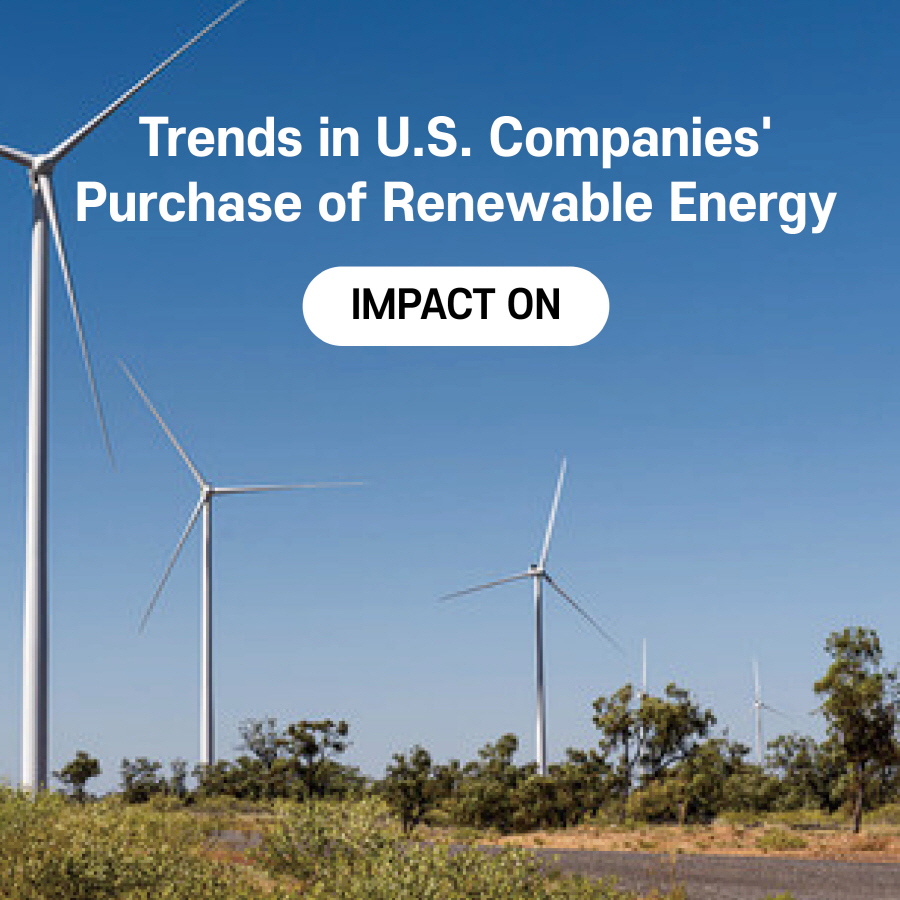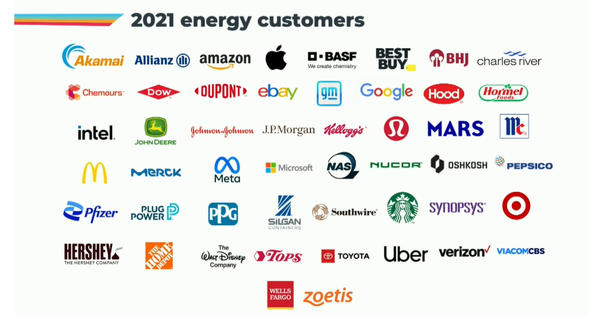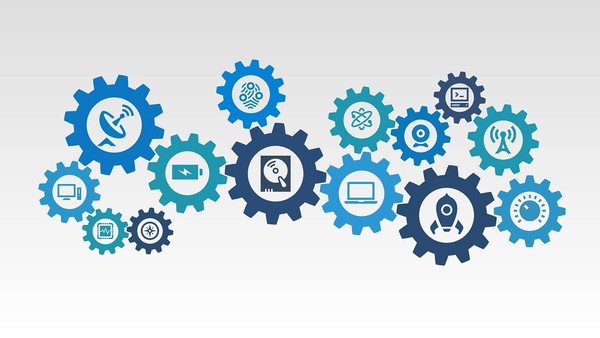
The U.S. companies are buying more and more renewable energy, drawing attention.
Apple announced on the 11th (local time) that it will launch a new renewable energy project for Apple products. They wanted to accomplish carbon neutrality by purchasing clean energy from a wind farm in Queensland, Australia. This is part of Apple's plan to achieve carbon neutrality across the entire business, manufacturing supply chain and product life cycle by 2030, a goal set by Apple in July 2020.
More than 70% of Apple's carbon footprint is generated from Scope1, 2, the energy used to manufacture the product, and Scope3, the electricity that customers use to power their devices, accounts for the remaining 22%.
Lisa Jackson, Apple's vice president of environment, said, "Apple recognizes that the climate crisis is an urgent issue and is stepping up global efforts to ensure that Apple's carbon footprint become net zero."
Apple says it will receive renewable energy from 2026 at the Upper Burdekin wind farm in Queensland, Australia. According to Apple, the project will provide energy to power 80,000 homes.
Investment in wind farms in Queensland, Australia is Apple's second renewable energy project. The first is the solar project announced in April. This is from a 2,300-acre (9.3 million square meters) power plant in Brown County, Texas, which is expected to generate 300MW of power when construction is completed later this year.
Amazon also increased its renewable energy portfolio by 30% last year and is using 3.5 GW of clean energy through 37 new wind and solar projects worldwide. The original goal was to use 100% of the company's operations as renewable energy by 2030, but this was moved up five years by 2025.
The trend of U.S. companies buying renewable energy is also confirmed by figures. According to the State of the Market, an annual report by the Canada Emergency Business Account (CEBA) released in May, corporate procurement in 2021 was 11.07GW, up from 10.73GW in 2020, with 26 out of 50 new suppliers.

According to the report, the median capacity of newly purchased renewable energy companies was around 51MW, smaller than the median capacity of existing companies, 80MW. This means that more small and medium-sized energy purchasing companies are increasing.
In particular, the new trend was Aggregation Deals. The joint purchase-type contract is a structure in which several contractors unite to sign one contract, and four cases were signed last year alone, with a total of 13 companies joining it.
Purchases of battery storage devices such as energy storage systems (ESSs) are also increasing. CEBA says 400MW of battery storage was purchased last year.
This trend is expanding to supply chain partners. According to the sustainability media GreenBiz, more than a dozen global companies, including PepsiCo, Wal-Mart, Johnson & Johnson, Pfizer, and AstraZeneca, can make Power Purchase Agreement (PPA).
According to a survey conducted earlier this year by SME Climate Hub, a climate consultative for small businesses run by non-profit climate organization ‘We Mean Business’, two-thirds of the 200 respondents complained of lack of adequate technology, knowledge, funding, or time to overcome the climate crisis, and only one-third received financial incentives from governments or large enterprises.
PepsiCo says it aims to integrate renewable energy purchase contracts in its supply chain through at least one collective contract by the end of the year. If all partners, including transportation, packaging, and purchase, convert renewable energy into electricity, they believe that Scpoe3, the most difficult part of decarbonization, will be possible.
Wal-Mart also operates a "Gigaton PPA" that allows its partners to procure renewable electricity. It is an initiative aimed at reducing 1 gigaton (1 billion metric tons) of carbon dioxide in the value chain by 2030, encouraging participants to cooperate in PPA. It will take time, but it is expected that the group PPA will take place within a year or two.

Ten global pharmaceutical companies, including Schneider Electric, AstraZeneca, Johnson & Johnson, Merck and Pfizer, created a joint initiative in November last year to discuss ways to collaborate on PPA and procurement in the renewable energy market.
Meanwhile, investment in renewable energy is increasing, and a methodology for evaluating the impact of renewable energy investment was developed earlier this year.
Goldman Sachs led an $80 million investment in renewable energy technology provider SkySpecs in May. Founded in 2012, Skyspec is a major business in managing renewable energy assets and provides data analysis solutions to check the failure and repair of renewable energy assets and improve productivity, efficiency, and return. It monitors approximately 45% of wind turbine blades in North America and manages 118 GW of renewable energy assets across 30 countries.
Global private equity investor Kolberg Kravis Roberts (KKR) launched Aster Renewable Energy, an Asian-centered renewable energy investment platform, in April. Astor will focus on building and operating solar, wind, and ESS in Taiwan and Vietnam, and will expand them to other Asian regions in the future.
In December last year, KKR launched Stellar Renewable Power, a new platform for long-term high-yield solar energy investment. In 2020, it launched Virescent Infrastructure, a platform that acquires, owns and operates renewable energy assets in India. KKR has secured $4 billion (about 5.2 trillion won) in global renewable energy assets over the past 10 years, which is 14.2 GW in terms of power generation capacity.
The Responsible Minerals Initiative (RMI) and the Energy Web (Energy Web) published an approach to assess the impact of companies buying renewable energy on emissions reduction in May.
The Renewable Energy Impact Assessment Methodology is to see the actual impact of purchasing renewable energy through tools such as the Renewable Energy Purchase Certificate (REC). For example, if you invest in new solar facilities in coal-rich areas such as Poland and India, you can have a much greater impact than REC purchases in California.
It is being piloted to bitcoin mining companies, which are known to be able to calculate the carbon strength of the energy used for mining, and to help identify the real impact by considering the renewable energy operation grid area.
[Global ESG_Now] 미국 기업들의 재생에너지 구매 확대 동향
미국 기업들의 재생에너지 구매가 점점 더 확대되고 있어 눈길을 끕니다.
애플(Apple)은 지난 11일(현지시각), 애플 제품에 공급되는 새로운 재생에너지 프로젝트를 시작한다고 발표했습니다. 호주 퀸즐랜드의 풍력 발전 단지에서 청정에너지를 구매함으로써 탄소 중립을 실천하고자 한 것입니다. 이는 2020년 7월에 애플이 설정한 목표인 2030년까지 전체 비즈니스, 제조 공급망 및 제품 수명 주기에 걸쳐 탄소 중립을 이루려는 계획의 일부입니다.
애플의 탄소 발자국 중 70% 이상은 제품 제조에 사용된 에너지인 Scope1, 2에서 생성되며, 고객이 기기에 전력을 공급하는 데 사용하는 전기인 Scope3는 나머지 22%를 차지하는 것으로 알려졌습니다.
애플의 환경 담당 부사장인 리사 잭슨은 “애플은 기후 위기가 시급한 문제라는 것을 인식하고 있으며, 애플 제품의 탄소 발자국이 넷제로가 되도록 하기 위해서 글로벌 노력에 박차를 가하고 있다”라고 말했습니다.
애플은 호주 퀸즐랜드에 위치한 어퍼 버데킨(Upper Burdekin) 풍력 발전 단지에서 2026년부터 재생에너지를 공급받을 예정이라고 전했습니다. 애플에 따르면, 이 프로젝트로 8만 가구에 전력을 공급할 수 있는 에너지를 얻을 수 있는 것으로 알려졌습니다.
호주 퀸즐랜드 풍력 발전소에 대한 투자는 애플이 진행하는 두 번째 재생에너지 프로젝트입니다. 첫 번째는, 지난 4월 발표한 태양광 프로젝트입니다. 이는 텍사스주 브라운 카운티에 위치한 2300에이커(930만 제곱미터) 규모의 발전소에서 진행되는 것으로, 올해 말 건설이 완료되면 300MW의 전력을 생산할 수 있을 것으로 전망됩니다.
아마존 또한 지난해 재생에너지 포트폴리오를 30%가량 늘렸고, 전 세계 37개의 새로운 풍력과 태양광 프로젝트를 통해 3.5GW의 청정에너지를 사용하고 있습니다. 당초 목표는 2030년까지 기업 운영의 100%를 재생에너지로 사용하겠다는 것이었으나, 이를 2025년까지 5년 앞당겼습니다.
이 같은 미국 기업들의 재생에너지 구매 흐름은 수치로도 확인됩니다. 지난 5월 발표된 청정에너지구매협회(Canada Emergency Business Account, CEBA)의 연례보고서인 ‘State of the Market’에 따르면, 미국에 본사를 둔 기업들이 체결한 재생에너지 거래 동향에서 2021년 기업 조달량은 11.07GW로 2020년(10.73GW))보다 늘어났으며, 50개 기업 중 26개 기업이 신규 조달자로 나타났습니다.
보고서에 따르면, 새로 재생에너지를 구매한 기업들의 용량의 중간값은 51MW 정도로, 기존 기업들의 용량의 중간값인 80MW에 비해 작은 규모였습니다. 이는 중소규모의 에너지 구매기업이 늘어나고 있다는 의미입니다.
특히, 새로운 트렌드는 ‘공동구매형 계약(Aggregation Deals)’이었습니다. 공동구매형 계약은 여러 곳의 계약자들이 뭉쳐 하나의 계약을 체결하는 구조인데, 지난해에만 4건이 체결됐고, 총 13개 기업이 여기에 합류했다고 합니다.
ESS(Energy Storage System・에너지저장장치)와 같은 배터리 저장장치의 구매도 늘고 있습니다. CEBA는 지난해 400MW의 배터리 저장장치 구매가 이뤄졌다고 밝혔습니다.
이러한 흐름은 공급망 협력업체들에게까지 확대되고 있습니다. 그린비즈에 따르면, 펩시코, 월마트, 존슨앤존슨, 화이자, 아스트라제네카 등 12개 이상의 글로벌 기업들이 공급망 통합 전력구매계약(Power Purchase Agreement, PPA)을 할 수 있도록 지원합니다.
비영리 기후단체 ‘위민비즈니스(We Mean Business)’가 운영하는 중소기업들의 기후협의체인 SME 클라이밋 허브(SME Climate Hub)가 올 초 실시한 조사에 따르면, 중소기업 200개 응답 기업의 3분의 2는 기후 위기를 극복할 수 있는 적절한 기술이나 지식, 자금, 시간이 없다고 호소했으며, 3분의 1만이 정부나 대기업으로부터 재정적 인센티브를 제공받은 것으로 나타났습니다.
펩시코는 연말까지 적어도 하나 이상의 단체계약을 통해 공급망의 재생에너지 구매계약을 통합하는 것을 목표로 한다고 밝혔습니다. 운송, 포장, 매입 등 모든 협력업체들이 재생에너지를 전기로 전환한다면, 탈탄소화에서 가장 어려운 부분인 Scpoe3 전환이 가능해질 것으로 보고 있습니다.
월마트도 협력업체가 재생 가능한 전기를 조달할 수 있는 ‘기가톤 PPA’를 운영합니다. 이는 2030년까지 가치사슬에서 1기가톤(10억미터톤)의 이산화탄소를 줄이는 것을 목표로 하는 이니셔티브로, 참가업체들에게 PPA에 대한 협력을 장려합니다. 시간이 걸리겠지만 1~2년 안에 그룹 PPA가 이뤄질 것으로 예상하는 분위기입니다.
슈나이더일렉트릭, 아스트라제네카, 존슨앤존슨, 머크, 화이자를 포함한 10개의 글로벌 제약회사는 지난해 11월 공동 이니셔티브를 만들어, 재생에너지 시장의 PPA 및 조달 협력을 하는 방안을 논의합니다.
한편, 재생에너지와 관련한 투자도 늘고 있고, 올 초에는 재생에너지 투자의 영향 평가 방법론도 개발됐습니다.
골드만삭스는 지난 5월 재생에너지 기술 제공업체인 스카이스펙스(SkySpecs)에 8000만달러(약 1044억원) 투자를 주도했습니다. 2012년 설립된 스카이스펙스는 재생에너지 자산 관리를 주요 사업으로 하는 기업으로, 재생에너지 자산의 고장과 수리 상태를 확인하고 생산성과 효율성, 수익률을 개선하기 위해 데이터 분석 솔루션을 제공합니다. 북미지역의 풍력터빈 블레이드의 약 45%를 모니터링하고, 30개국에 걸쳐 118GW의 재생에너지 자산을 관리합니다.
글로벌 사모투자자 콜버그크래비스로버츠(KKR)는 지난 4월 아시아 중심의 재생에너지 투자 플랫폼인 애스터(Aster Renewable Energy)을 론칭했습니다. 애스터는 대만과 베트남 지역의 태양광, 풍력, ESS 등의 구축과 운영에 주력하고, 이를 향후 다른 아시아 지역으로 확대할 방침입니다.
KKR은 지난해 12월 장기 고수익 태양광 투자를 위한 새로운 플랫폼인 스텔라리뉴어블파워(Stellar Renewable Power)를 출시한 바 있습니다. 또, 2020년에는 인도에서 재생에너지 자산을 인수, 소유, 운용하는 플랫폼인 비레센트 인프라(Virescent Infrastructure)를 출시했습니다. KKR은 지난 10년 동안 글로벌 재생에너지 자산 규모로 40억달러(약 5조2000억원)를 확보했는데, 이를 발전용량으로 치면 14.2GW에 달하는 규모입니다.
RMI(Responsible Minerals Initiative・책임광물이니셔티브)와 에너지웹(Energy Web)은 기업이 재생에너지 구매를 통해 배출량 감소에 미치는 영향을 평가하기 위한 접근방법론을 지난 5월 발표했습니다.
재생에너지 영향 평가 방법론은 REC(재생에너지 구매인증서)와 같은 툴을 통해 재생에너지를 구매할 경우 실제 영향이 어느 정도인지 보는 것입니다. 예를 들어, 폴란드와 인도 같이 석탄이 많은 지역에서 새로운 태양광시설에 투자하면, 캘리포니아 지역의 REC 구매보다 훨씬 더 큰 임팩트를 낼 수 있다고 합니다.
이를 비트코인 채굴업체들에 시범 적용하고 있는데, 채굴을 위해 사용된 에너지의 탄소 강도를 계산할 수 있고, 재생에너지 운영 그리드 지역을 고려함으로써 실질적인 영향을 파악하는 데 도움을 줄 수 있다고 알려졌습니다.
